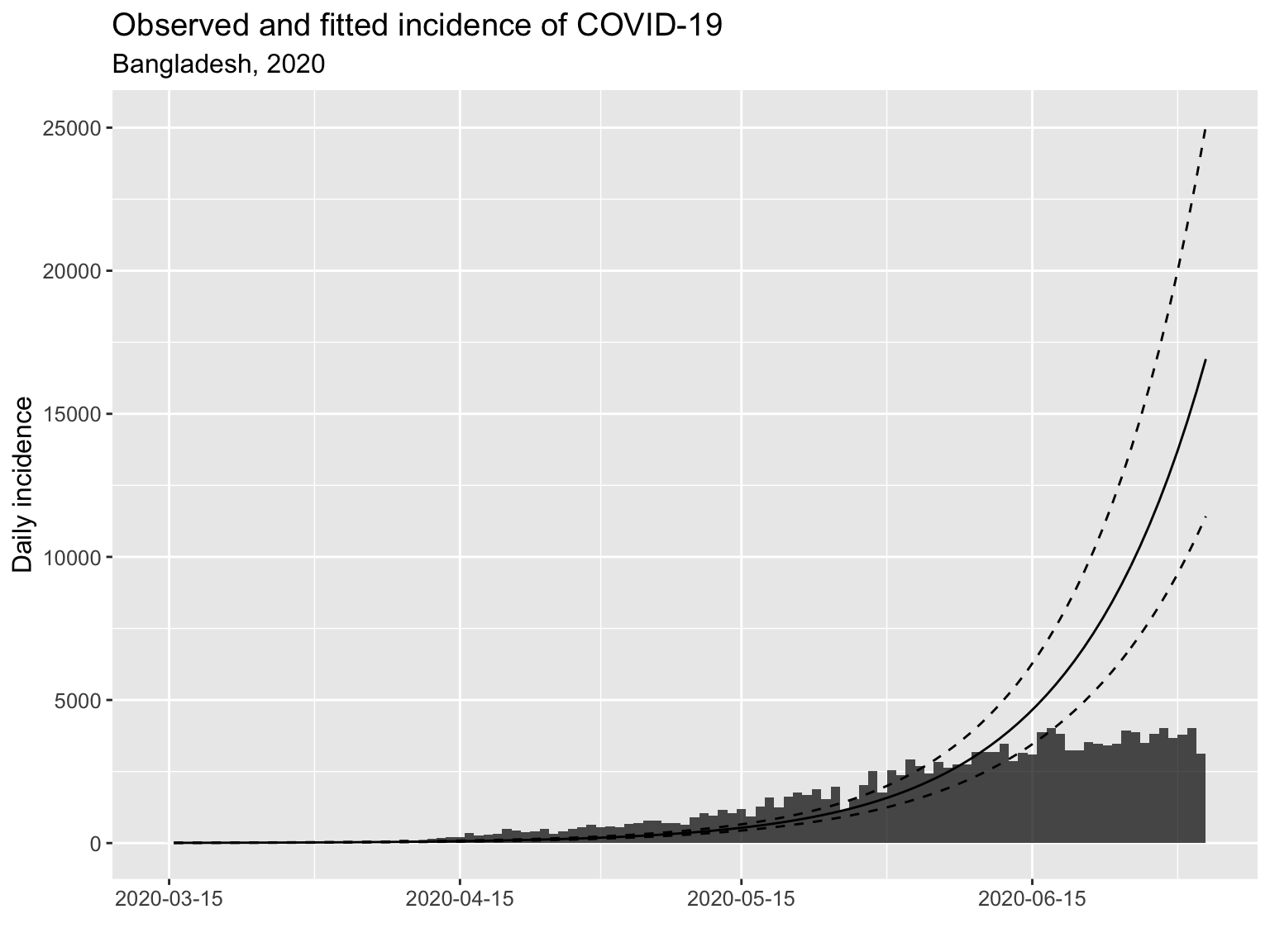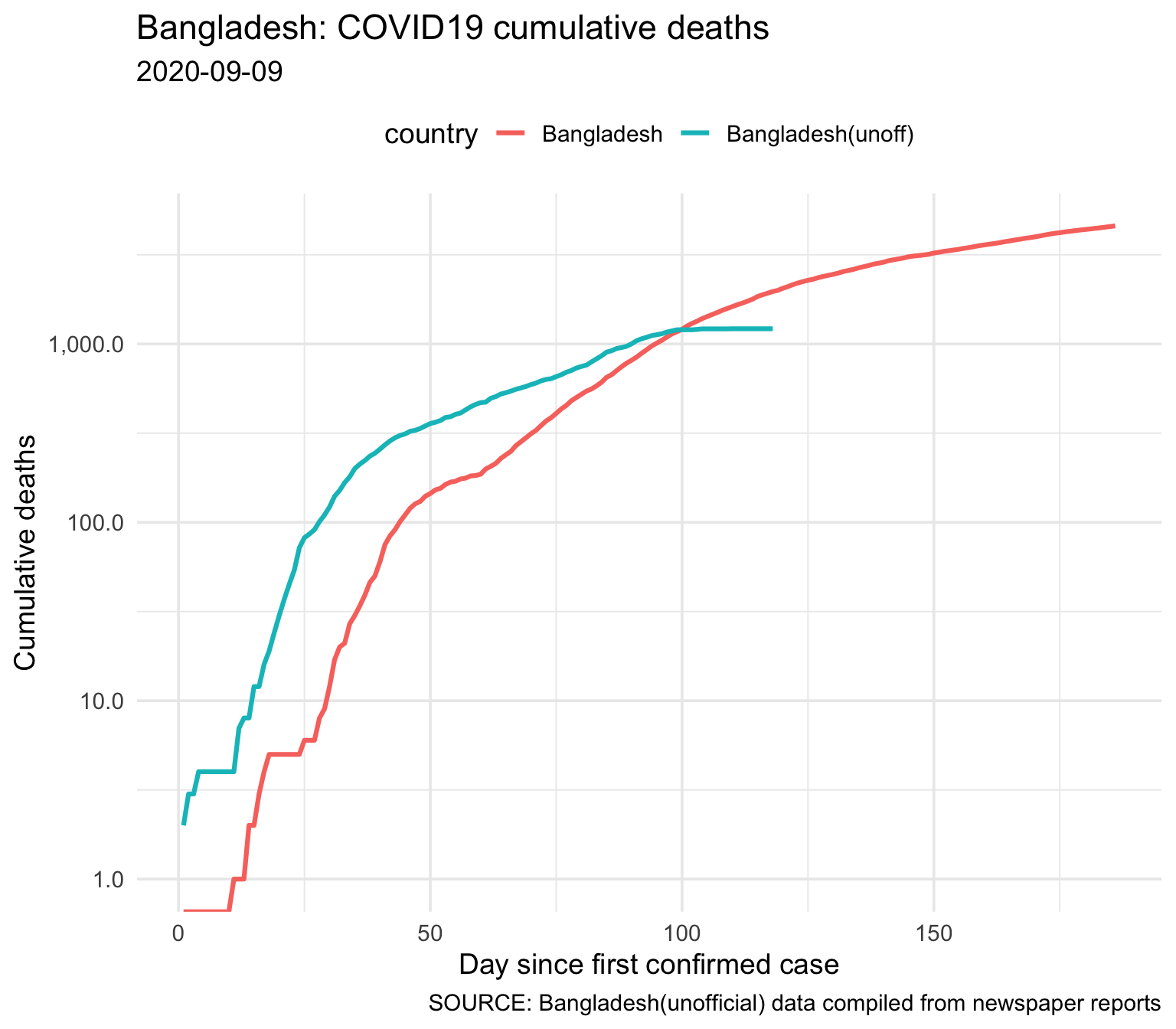Report 3 Bangladesh
This report is created based on a publicly available data. The data are available on a Google Sheet. Please see the Data Source section for link. Please note that publicly available data are not official and MAY BE UNRELIABLE. I personally did not verify them. I am using them for educational purposes. Use at your discretion.
3.1 Epidemic curve and search for peak
The epidemic curve for Bangladesh and a tentative peak. The red line in the plot indicates a potential peak based on available data. IF the peak (red line) is at the far right, then we may not have reached a peak yet. We must have sustained decrease of incidences to be sure about any peak.

We fit a log linear model to estimate the doubling time (growh phase) and halving time (decline phase, when that happens). The estimated fitted line (solid line) with 95% confidence interval (dotten lines) are superimposed on the epidemic curve below.

The current doubling time as of 2020-09-10 is 9.9 days with a 95% confidence interval of (9.1, 10.9) days.
3.1.1 Estimating the Overall Reproduction Number,
The log-linear model estimates the as follows:

## Min. 1st Qu. Median Mean 3rd Qu. Max.
## 1.511 1.567 1.591 1.592 1.612 1.6793.1.2 Estimating the Effectuve Reproduction Number ()
The estimation of effective reproduction number involves the distribution of serial interval (SI). Based on the literature (REF to be added), a gamma distribution with mean 7.5 and standard deviation 3.5

3.1.3 Simulating the on Weekly Sliding Window
Now we perform a simulation of different SI distribution to obtain the . For this, we vary the parameters of gamma distribution and obtain the following.
# Recalculating with varying SI distribution parameters
# we get these results:
config = make_config(list(mean_si = 7.5, std_mean_si = 3.5,
min_mean_si = 2, max_mean_si =10.0,
std_si = 3.5, std_std_si = 1,
min_std_si = 0.5, max_std_si = 4))
bd_res_uncertain_si <-
estimate_R(bd_confirmed_cases$daily_cases, method = "uncertain_si",
config = config)
plot_Ri(bd_res_uncertain_si)
| t_start | t_end | Mean(R) | Std(R) | Quantile.0.025(R) | Quantile.0.975(R) | |
|---|---|---|---|---|---|---|
| 105 | 106 | 112 | 1.046632 | 0.0169938 | 1.0189608 | 1.081899 |
| 106 | 107 | 113 | 1.049673 | 0.0145129 | 1.0231781 | 1.079145 |
| 107 | 108 | 114 | 1.064205 | 0.0138124 | 1.0355469 | 1.090588 |
| 108 | 109 | 115 | 1.067638 | 0.0154839 | 1.0303541 | 1.093207 |
| 109 | 110 | 116 | 1.072344 | 0.0178503 | 1.0300534 | 1.099355 |
| 110 | 111 | 117 | 1.066645 | 0.0202760 | 1.0205370 | 1.096095 |
| 111 | 112 | 118 | 1.027756 | 0.0209605 | 0.9843239 | 1.059694 |
The effective reproduction number based on the last week’s incidences show an average of 1.03 with a 95% confidence interval (0.98, 1.06).
3.1.4 Simulating on a Monthly Sliding Window
| t_start | t_end | Mean(R) | Std(R) | Quantile.0.025(R) | Quantile.0.975(R) | |
|---|---|---|---|---|---|---|
| 59 | 60 | 89 | 1.328111 | 0.1218987 | 1.093749 | 1.527731 |
| 60 | 61 | 90 | 1.326367 | 0.1225633 | 1.096821 | 1.529301 |
| 61 | 62 | 91 | 1.319118 | 0.1219674 | 1.093018 | 1.523864 |
| 62 | 63 | 92 | 1.312845 | 0.1204491 | 1.092004 | 1.517296 |
| 63 | 64 | 93 | 1.306606 | 0.1180362 | 1.090871 | 1.508910 |
| 64 | 65 | 94 | 1.303426 | 0.1154575 | 1.092073 | 1.502786 |
| 65 | 66 | 95 | 1.296084 | 0.1126439 | 1.088118 | 1.490242 |
| 66 | 67 | 96 | 1.289401 | 0.1097843 | 1.086316 | 1.478005 |
| 67 | 68 | 97 | 1.284089 | 0.1072704 | 1.085707 | 1.467915 |
| 68 | 69 | 98 | 1.268620 | 0.1041213 | 1.075342 | 1.446044 |
| 69 | 70 | 99 | 1.256148 | 0.1003377 | 1.072203 | 1.427868 |
| 70 | 71 | 100 | 1.248356 | 0.0963948 | 1.073534 | 1.414545 |
| 71 | 72 | 101 | 1.247968 | 0.0931521 | 1.078450 | 1.409307 |
| 72 | 73 | 102 | 1.243734 | 0.0904911 | 1.077346 | 1.399898 |
| 73 | 74 | 103 | 1.241699 | 0.0882930 | 1.077199 | 1.392902 |
| 74 | 75 | 104 | 1.224717 | 0.0856263 | 1.063337 | 1.370345 |
| 75 | 76 | 105 | 1.206741 | 0.0819941 | 1.054814 | 1.345852 |
| 76 | 77 | 106 | 1.195827 | 0.0779376 | 1.055362 | 1.329129 |
| 77 | 78 | 107 | 1.182595 | 0.0735190 | 1.051625 | 1.310244 |
| 78 | 79 | 108 | 1.174473 | 0.0690322 | 1.052361 | 1.295629 |
| 79 | 80 | 109 | 1.162138 | 0.0643547 | 1.047242 | 1.275574 |
| 80 | 81 | 110 | 1.168266 | 0.0606673 | 1.060065 | 1.275402 |
| 81 | 82 | 111 | 1.168308 | 0.0584652 | 1.058817 | 1.269725 |
| 82 | 83 | 112 | 1.157930 | 0.0568349 | 1.048442 | 1.254106 |
| 83 | 84 | 113 | 1.146390 | 0.0549897 | 1.041503 | 1.238319 |
| 84 | 85 | 114 | 1.147418 | 0.0532516 | 1.048453 | 1.236274 |
| 85 | 86 | 115 | 1.135368 | 0.0515691 | 1.038929 | 1.221583 |
| 86 | 87 | 116 | 1.127179 | 0.0492675 | 1.037022 | 1.210468 |
| 87 | 88 | 117 | 1.116696 | 0.0464521 | 1.032996 | 1.196648 |
| 88 | 89 | 118 | 1.099904 | 0.0429453 | 1.023926 | 1.175051 |
The effective reproduction number based on the last months’s incidences show an average of 1.1 with a 95% confidence interval (1.02, 1.18).
3.1.5 Cumulative Deaths (official and unofficial)

| country | Total Deaths |
|---|---|
| Bangladesh | 4593 |
| Bangladesh(unoff) | 1217 |
3.2 Bangladesh in South Asia
3.2.1 Infection

| country | Total Cases |
|---|---|
| India | 4465863 |
| Bangladesh | 331078 |
| Pakistan | 300030 |
| Indonesia | 203342 |
| Bangladesh(unoff) | 156391 |
| Singapore | 57166 |
| Nepal | 49219 |
| Malaysia | 9583 |
| Sri Lanka | 3147 |
| Bhutan | 234 |
3.2.2 Deaths

| country | Total Deaths |
|---|---|
| India | 75062 |
| Indonesia | 8336 |
| Pakistan | 6365 |
| Bangladesh | 4593 |
| Bangladesh(unoff) | 1217 |
| Nepal | 312 |
| Malaysia | 128 |
| Singapore | 27 |
| Sri Lanka | 12 |
| Bhutan | 0 |
3.2.3 Cases and deaths compared on a specific day
Bangladesh has entered into day 186 since first confirmed case.
| Country | Total cases | Total deaths |
|---|---|---|
| India | 1803695 | 38135 |
| Indonesia | 184268 | 7750 |
| Pakistan | 295053 | 6283 |
| Bangladesh | 331078 | 4593 |
| Malaysia | 8943 | 124 |
| Nepal | 19063 | 49 |
| Singapore | 50369 | 27 |
| Sri Lanka | 2814 | 11 |
| Bhutan | 233 | 0 |